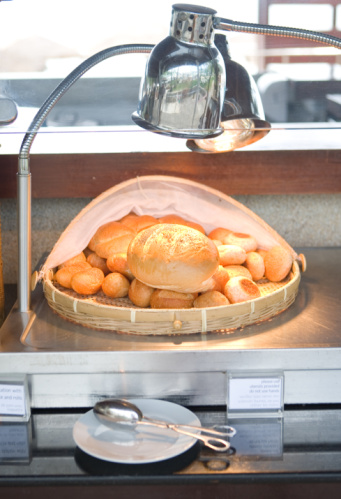
A few months ago, I read an interesting article in The New Yorker that discussed the rise of Purell and the ubiquity of hand sanitizers. One comment particularly caught my attention:
During a recent trip to Europe, I was mildly alarmed to find no serving tongs in the breadbasket on my hotel’s breakfast-buffet table: the only way to pick up a croissant was with my fingers. But then I realized that when I took a croissant barehanded I touched only the one that I was going to eat, whereas if I’d used tongs I’d have handled an implement that had been touched by every diner who came before me. Tongs are an example of what epidemiologists call fomites—objects that convey infectious agents between individuals.
This excerpt really struck me, because it reminded me of a deli I regularly patronize. It does a thriving lunchtime business, and has a unique (in my experience) system, wherein assorted types of rolls are left in bins for customers to choose and hand to the sandwich maker. Atop the bins are several plastic tongs, and customers (like me) dutifully use these tongs to select their bun of choice.
Reading this piece hit me with the unquestionable, unvarnished truth: each time I use the tongs, I am increasing the risk of transmitting an infectious agent, both to myself and to every other customer using those tongs.
As a medical and public health professional, I was immediately embarrassed that I had not previously considered this, and I resolved to mend my ways.
And here’s my even more embarrassing confession: after many harsh and disapproving looks from other customers when using the proper method, I went back to using the tongs for a short while. So, even though I knew the hand-selection approach was safer, I briefly succumbed to the majority-rule principle: since almost everyone else used the tongs and clearly believed that their approach was more healthful and considerate, I went along with this even though I knew it was wrong.
I have since decided to do the right thing: now I screw my courage to the sticking place and select my roll by hand, enduring the cold and angry stares of others around me. Yes, I know they view me as Typhoid Mary, but I say to myself: it doesn’t matter what they think, I know I’m following the safer public-health path.
As we enter the cold and flu season, I anticipate that those harsh looks may turn into aggressive comments, but I intend to stand strong.
This choice is relatively easy, insofar as it is fact-based, and not a question that requires inference or judgment to answer. It is an undeniable, scientific fact that picking up your roll by hand is safer than using tongs (although, of course, neither is particularly dangerous). If there were an opinion poll that said that the majority of Americans believe using tongs is safer, that wouldn’t make it so—just as, if most Americans agreed with the oft-cited statement that the U.S. has the best healthcare system in the world, that wouldn’t make it true, because it is demonstrably false.
The whole thing gets muddier in those situations where judgment and inference are required—that is, in most situations.
In such cases, we ought to seek not “consensus,” but evidence-based conclusions. Such as: is global climate change a result of human activity? How much salt is too much to eat? Should men be screened for prostate cancer? Such questions are often politicized and evoke strong feelings, which is understandable given that absolute certainty is almost never achievable. Still, we owe it to ourselves to make such judgments based on reason rather than passion.
Now, time to go out and grab a sandwich….


Comments on this entry are closed.
Anyone who thinks tongs are hazardous should consider the practice of dining in China. Food is served in dishes on a Lazy Susan that diners at the same table rotate to select their items. All diners use their own chopsticks to pluck out the food, put it on their plates or directly into their mouths, and proceed to the next dish. I was in China last week and did as the natives do, but I commented to my fellow diners on the risk of transmitting infections. Some people scoffed at the idea, while others acknowledged that on occasion a pair of “serving chopsticks” are used. Unlike the option to use the barehanded approach to pick up a roll, the germ-phobic diner in China has no choice in the communal setting. Dip your chopsticks into the dish of your choice, or starve.
Very nice article, Dr Marantz. I always considered that, thinking that as long as people don’t shuffle around the options, you are in fact only touching your own bread… Now I have a more compelling reasoning with your article.
Can you get the bread out without touching the door that the same people who used the tongs touched?